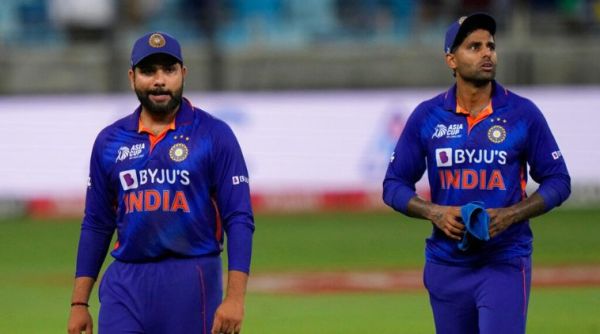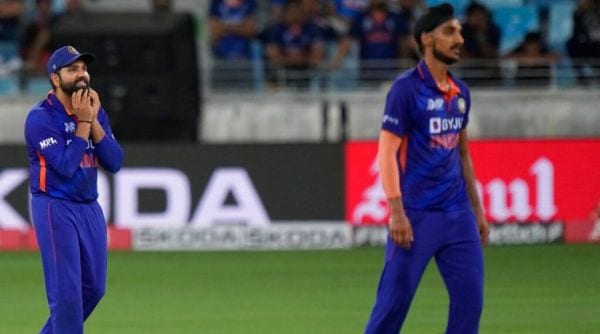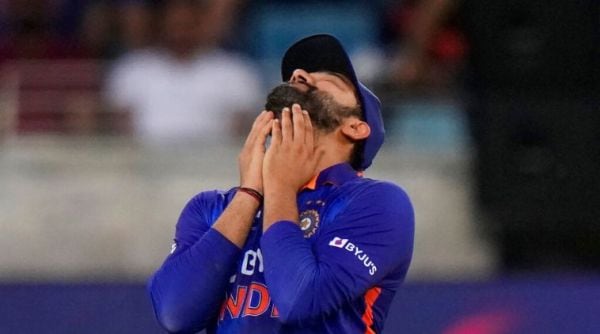 India's captain Rohit Sharma, center, interacts with teammates during the T20 cricket match of Asia Cup between Sri Lanka and India, in Dubai, United Arab Emirates, Tuesday, Sept. 6, 2022. (AP Photo/Anjum Naveed)
India's captain Rohit Sharma, center, interacts with teammates during the T20 cricket match of Asia Cup between Sri Lanka and India, in Dubai, United Arab Emirates, Tuesday, Sept. 6, 2022. (AP Photo/Anjum Naveed)In search of perfection, India have stumbled on imperfections. After months of experimenting, the Asia Cup was supposedly the final piece in the jigsaw before the World Cup next month. A time to stop the year-long experimenting spree, to lay down the blueprint that would define them, to iron out the remaining glitches, polish the tactics, fine-tune the combinations, a fortnight to get into tournament groove, nail down a fixed, viable eleven and reflect on how far they have progressed from the early exit in the previous World Cup on these same shores.
There was faith and hope, joy and belief, as they landed in Dubai having won seven of their last seven series. But in the duration of three days, in the space of two Super Four defeats in the Asia Cup, India’s flaws and failings have been exposed.
Dk or Pant? Bishnoi or Chahal? Bhuvi or Arshdeep?
The middle-order looks as uncertain as they are unsettled. After all the elaborate and extended shuffling of the personnel, they are inconclusive whether to pick Dinesh Karthik or Deepak Hooda, where Rishabh Pant should bat, at five or six, or whether he should be in the playing eleven at all? Or who among Karthik and Pant offers more fire-power. They don’t know who their best spinners are, Ravi Bishnoi or Ravi Ashwin or Yuzvendra Chahal? They don’t know who the best death bowlers are—Bhuvneshwar Kumar, Arshdeep Singh or Avesh Khan.
Some of their worries would be allayed by the return of Jasprit Bumrah, Harshal Patel, but not all. Bumrah cannot alone provide the incision at the top and rattle at the death, just as Patel alone cannot snuff out the wickets at the death. And Patel, let it not be forgotten, is still treading the incipient stage of his career. There have been days when he has bled plenty too. On wickets where the ball holds up, he has the game to ace it but on flatter true tracks, can one say, as yet, that he has the answers?
 India’s captain Rohit Sharma, left, reacts as he leaves the field with teammate Suryakumar Yadav after their loss in the T20 cricket match of Asia Cup against Sri Lanka, in Dubai, United Arab Emirates, Tuesday, Sept. 6, 2022. (AP Photo/Anjum Naveed)
India’s captain Rohit Sharma, left, reacts as he leaves the field with teammate Suryakumar Yadav after their loss in the T20 cricket match of Asia Cup against Sri Lanka, in Dubai, United Arab Emirates, Tuesday, Sept. 6, 2022. (AP Photo/Anjum Naveed) Where are the bowling options?
In any case, a team should have a variety of bowlers able to perform a variety of roles. For instance, Pakistan could pick any one from Naseem Shah, Mohammad Hasnain and Haris Rauf to pick the new ball or bowl at the death overs. The depth is fearsome if you add Shaheen Shah Afridi and Shahnawaz Dahani. Or Australia, who could just summon any of Josh Hazlewood, Mitchell Starc or Pat Cummins to depute any role, be it early wickets, middle-overs choke or death-over kill.
But India have fundamental fault lines. Bhuvneshwar has been as lethal as ever with new ball but when he endured a one bad day, as it unravelled against Sri Lanka, there was no one to make up for him, no one to stand up and seize the day. And as evolved a death bowler he has become, the lack of pure pace does not make him as feared as Bumrah or Afridi. Both against Pakistan and Sri Lanka, his 19th over proved costly. Against the latter, he leaked 14; against the former 19. The idea was to use him, the most experienced and skilled bowler in the team, in the 19th over so that Arshdeep would have more runs to defend. Turned out to be the exact opposite. Bhuvneshwar’s tactics at times were strange, his field placements easily conveyed his intentions. In both instances, it became a matter of just taking the chase to the death overs, and latching onto Bhuvneshwar, Arshdeep and Pandya, who again is a better new-ball and middle-over bowler than a death-over destroyer. Even if this was India’s second-rung bowling , their flatness was appalling.
What if Bumrah gets injured or has a bad day?
It also prompts this eventuality—what if Bumrah gets injured? The alternatives are the likes of Avesh and Arshdeep.
This could be potentially India’s undoing in the World Cup in Australia—only Bumrah among this group, which both Rahul Dravid and Rohit Sharma say would remain more or less the same for the World Cup, has the virtues of pace, aggression and craft to make a difference in the last four overs.
 India’s captain Rohit Sharma, left, and Arshdeep Singh, right, react as Sri Lankan batters score runs during the T20 cricket match of Asia Cup between Sri Lanka and India, in Dubai, United Arab Emirates, Tuesday, Sept. 6, 2022. (AP Photo/Anjum Naveed)
India’s captain Rohit Sharma, left, and Arshdeep Singh, right, react as Sri Lankan batters score runs during the T20 cricket match of Asia Cup between Sri Lanka and India, in Dubai, United Arab Emirates, Tuesday, Sept. 6, 2022. (AP Photo/Anjum Naveed) Even Patel, crafty as he is, could be lined up for big blows, like when the Irish batsmen tore into him in Dublin (4-0-54-0), or the Sri Lankans in Dharamshala (4-0-52-1). To think that the team management pencilled in on this group after extensive auditioning—from Mohammad Siraj to Mohammad Shami and Umran Malik and Avesh Khan—baffles the mind. The question that a journalist asked Rahul Dravid—whether Pakistan’s bowling attack is smoother—looks more relevant now than when it was asked.
True experimentation or just a spin?
In hindsight, the experimenting spree strikes hollow. Some of the frequent changes were due to injuries, illnesses and workload management, but both the coach and captain had admitted in the past that they were trying out different personnel to figure out the best possible combination. The more matches they have played the more confused they have looked. Too many matches—between the last World Cup and Asia Cup, they have played twenty eight games, more than any other team in the world—seem to have distorted the vision forward. Or rather, they have just helped in cluttering the formulas and strategies.
Experiments can indeed misfire, go askance, can consume time, but you cannot be experimenting for an eternity, not least when the World Cup is next month. Not when you are playing in a multi-team tournament, when all other teams are fielding their best combination.
But Sharma defended the tactics. “When you talk about experiments, yes, we wanted to try out certain things. If you look at the combination we have been playing before the start of the Asia Cup, it was with four seamers, two spinners and the second spinner was an allrounder. I always wanted to try and find answers as to what happens if you play with three seamers and two spinners, and the third spinner being an allrounder,” he elaborated. All these are fine, but two months before the World Cup.
 India’s captain Rohit Sharma reacts during the T20 cricket match of Asia Cup between Sri Lanka and India, in Dubai, United Arab Emirates, Tuesday, Sept. 6, 2022. (AP Photo/Anjum Naveed)
India’s captain Rohit Sharma reacts during the T20 cricket match of Asia Cup between Sri Lanka and India, in Dubai, United Arab Emirates, Tuesday, Sept. 6, 2022. (AP Photo/Anjum Naveed) The pieces of the jigsaw puzzle now are disarrayed and disarranged. Ironically, the one unfitting block—the top three—had fitted in perfectly. Along with the insuperable Suryakumar Yadav, they look India’s strongest suit. The lower middle order is less so. Hardik Pandya could be a 4-5-6 floater, but there is no clarity regarding where Pant should bat. Should he come ahead of Pandya or below him? The Pant-versus-Karthik debate rages on too. If KL Rahul fails more, then Pant would be talked up for that role too.
To muddy the muddied waters, they have thrown Deepak Hooda into the mix. What is his identity—spinner-allrounder? But he has bowed just 30 balls in 11 games. Or is he being groomed as a finisher? If so, is he not redundant, as they already have Pant and Pandya? He seems bogus, and a more like-for-like replacement for the injured Jadeja was Axar Patel. The more answers you seek, the more questions that confound you.
Curious case of R Ashwin
Axar is among the six spinners India have played in the last 15 games. Jadeja-Chahal seemed the preferred combination, but Jadeja’s knee injury and Chahal’s inconsistency has warranted a rethink. Ravi Ashwin’s case is baffling. Since his T20 comeback last year, he has maintained a thrifty economy rate of 5.75, while taking nine wickets in eight games. Yet, he is not an automatic choice. Dravid reasoned it during a press conference: “The fact is that the wrist-spinners can spin it both ways, doesn’t expose them to the left-handers or the right-handers as much as the finger spinners.” But against Sri Lanka, with a left-hand heavy middle-order, he sacrificed Ravi Bishnoi for Ashwin. For a long time, India had made their wrist-spin fixation clear.
Against a torrent of questions on over-experimenting as well as the twin defeats, Sharma put on a tranquil face. “Yes, there are a lot of questions we need to answer, and along the way, in the three-four series we’ve played, we have found some answers. There will be a time where we will draw a line and say, ‘this is the combination we want to play for the World Cup.’ After this, we have two more series and then the World Cup. Till our squad is announced, we can try out a few players,” he said. The quest for perfection continued, even if time is fast running out.